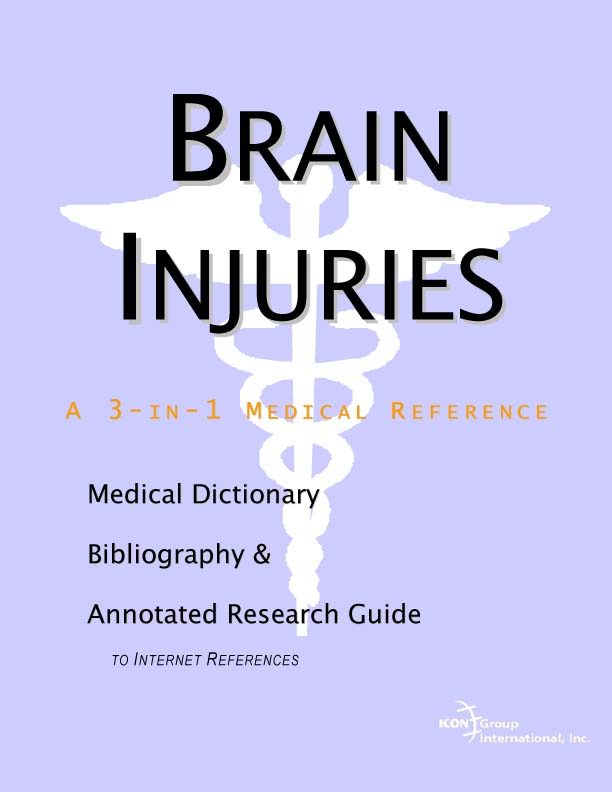Official Health Sourcebooks
|
|
ICON Health Publications Official Health Sourcebooks |
BRAIN INJURIES
A Bibliography, Medical Dictionary,
and
Annotated Research Guide to Internet References
(Brain Injuries)


| P
A P E R B A C K |
|
||||
|
| E
B O O K |
| Pages | : | 240 |
| Price | : | $28.95(USD) |
| ISBN | : | 0597837988 |
| Published | : | 2003 |
| Synopsis | |
In March 2001, the National Institutes of Health issued the following warning: "The number of Web sites offering health-related resources grows every day. Many sites provide valuable information, while others may have information that is unreliable or misleading." Furthermore, because of the rapid increase in Internet-based information, many hours can be wasted searching, selecting, and printing. Since only the smallest fraction of information dealing with brain injuries is indexed in search engines, such as www.google.com or others, a non-systematic approach to Internet research can be not only time consuming, but also incomplete. This book was created for medical professionals, students, and members of the general public who want to conduct medical research using the most advanced tools available and spending the least amount of time doing so. |
| Related Conditions/Synonyms | |
| Brain Injuries |
Description |
|
This is a 3-in-1 reference book. It gives a complete medical dictionary covering hundreds of terms and expressions relating to brain injuries. It also gives extensive lists of bibliographic citations. Finally, it provides information to users on how to update their knowledge using various Internet resources. The book is designed for physicians, medical students preparing for Board examinations, medical researchers, and patients who want to become familiar with research dedicated to brain injuries. If your time is valuable, this book is for you. First, you will not waste time searching the Internet while missing a lot of relevant information. Second, the book also saves you time indexing and defining entries. Finally, you will not waste time and money printing hundreds of web pages. |
|
Table of Contents |
|
Forward Chapter 1. Studies on Brain Injuries Overview The Combined Health Information Database Federally Funded Research on Brain Injuries E-Journals: PubMed Central The National Library of Medicine: PubMed Chapter 2. Nutrition and Brain Injuries Overview Finding Nutrition Studies on Brain Injuries Federal Resources on Nutrition Additional Web Resources Chapter 3. Alternative Medicine and Brain Injuries Overview National Center for Complementary and Alternative Medicine Additional Web Resources General References Chapter 4. Dissertations on Brain Injuries Overview Dissertations on Brain Injuries Keeping Current Chapter 5. Clinical Trials and Brain Injuries Overview Recent Trials on Brain Injuries Keeping Current on Clinical Trials Chapter 6. Patents on Brain Injuries Overview Patents on Brain Injuries Patent Applications on Brain Injuries Keeping Current Chapter 7. Books on Brain Injuries Overview Book Summaries: Federal Agencies Book Summaries: Online Booksellers The National Library of Medicine Book Index Chapters on Brain Injuries Chapter 8. Multimedia on Brain Injuries Overview Video Recordings Bibliography: Multimedia on Brain Injuries Chapter 9. Periodicals and News on Brain Injuries Overview News Services and Press Releases Academic Periodicals covering Brain Injuries Chapter 10. Researching Medications Overview U.S. Pharmacopeia Commercial Databases Appendix A. Physician Resources Overview NIH Guidelines NIH Databases Other Commercial Databases Appendix B. Patient Resources Overview Patient Guideline Sources Associations and Brain Injuries Finding Associations Appendix C. Finding Medical Libraries Overview Preparation Finding a Local Medical Library Medical Libraries in the U.S. and Canada ONLINE GLOSSARIES Online Dictionary Directories BRAIN INJURIES DICTIONARY INDEX |
Excerpt (Introduction) |
|
|
In addition to offering a structured and comprehensive bibliography, this medical reference on brain injuries will quickly direct you to resources and reliable information on the Internet, from the essentials to the most advanced areas of research. Public, academic, government, and peer-reviewed research studies are emphasized. Various abstracts are reproduced to give you some of the latest official information available to date. Abundant guidance is given on how to obtain free-of-charge primary research results via the Internet. E-book and electronic versions of this book are fully interactive with the Internet. For readers unfamiliar with the Internet, detailed instructions are offered on how to access electronic resources. For readers unfamiliar with medical terminology, a comprehensive glossary is provided. For readers without access to Internet resources, a directory of medical libraries, that have or can locate references cited here, is given. We hope these resources will prove useful to the widest possible audience seeking information on brain injuries. |
Words Defined in the Vocabulary Builders |
|